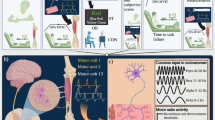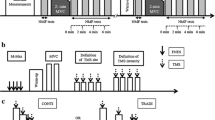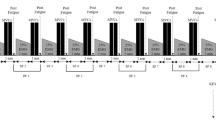Abstract
We have previously shown that following a period of unimanual fatiguing exercise, there is a reduction in primary sensorimotor cortex (SM1) activation with movement of either the fatigued or the non-fatigued hand by Benwell et al. (Exp Brain Res 167:160–164, 2005). In the present study we have investigated whether this reduction is confined to motor areas or is more widespread. Functional imaging was performed before and after a 10-minute fatiguing exercise of the left hand (30% of maximum handgrip strength) in seven normal subjects (4 M, mean age 25 years). The activating task was a handgrip against a low resistance (1 kg) in response to a visual cue (chequerboard reversal every 2 ± 0.5 s). We compared activation in SM1, supplementary motor area (SMA), cerebellum (CB) and primary visual cortex (V1) before and after the fatiguing exercise. After exercise, contralateral SM1 activation was reduced by 33% (P < 0.05) compared to baseline for the fatigued hand and by 49% for the non-fatigued hand (P < 0.05). A similar pattern was seen for the bilateral SMA and ipsilateral CB following exercise (45 vs. 50% for SMA; 30 vs. 35% for CB; fatigued versus non-fatigued). Activation was also reduced in V1 but to a lesser extent than in motor areas (19 vs. 24%; fatigued versus non-fatigued). These results show that although the reduced functional activation during the recovery period after fatiguing exercise is more marked in motor areas, it also extends to non-motor areas such as the visual cortex, suggesting that there are more widespread changes in cerebral haemodynamic responses after fatigue.





Similar content being viewed by others
References
Bandettini PA, Kwong KK, Davis TL, Tootell RB, Wong EC, Fox PT, Belliveau JW, Weisskoff RM, Rosen BR (1997) Characterization of cerebral blood oxygenation and flow changes during prolonged brain activation. Hum Brain Mapp 5:93–109
Benwell NM, Byrnes ML, Mastaglia FL, Thickbroom GW (2005) Primary sensorimotor cortex activation with task-performance after fatiguing hand exercise. Exp Brain Res 167:160–164
Benwell NM, Sacco P, Hammond GR, Byrnes ML, Mastaglia FL, Thickbroom GW (2006) Short-interval cortical inhibition and corticomotor excitability with fatiguing hand exercise: a central adaptation to fatigue? Exp Brain Res 170:191–198
Bonato C, Zanette G, Manganotti P, Tinazzi M, Bongiovanni G, Polo A, Fiaschi A (1996) ‘Direct’ and ‘crossed’ modulation of human motor cortex excitability following exercise. Neurosci Lett 216:97–100
Brasil-Neto JP, Pascual-Leone A, Valls-Sole J, Cammarota A, Cohen LG, Hallett M (1993) Postexercise depression of motor evoked potentials: a measure of central nervous system fatigue. Exp Brain Res 93:181–184
Dalsgaard MK, Volianitis S, Yoshiga CC, Dawson EA, Secher NH (2004) Cerebral metabolism during upper and lower body exercise. J Appl Physiol 97:1733–1739
Humphry AT, Lloyd-Davies EJ, Teare RJ, Williams KE, Strutton PH, Davey NJ (2004) Specificity and functional impact of post-exercise depression of cortically evoked motor potentials in man. Eur J Appl Physiol 92:211–218
Ide K, Schmalbruch IK, Quistorff B, Horn A, Secher NH (2000) Lactate, glucose and O2 uptake in human brain during recovery from maximal exercise. J Physiol 522(Pt 1):159–164
Jancke L, Peters M, Schlaug G, Posse S, Steinmetz H, Muller-Gartner H (1998) Differential magnetic resonance signal change in human sensorimotor cortex to finger movements of different rate of the dominant and subdominant hand. Brain Res Cogn Brain Res 6:279–284
Lazarski JP, Ridding MC, Miles TS (2002) Dexterity is not affected by fatigue-induced depression of human motor cortex excitability. Neurosci Lett 321:69–72
Liu JZ, Dai TH, Sahgal V, Brown RW, Yue GH (2002) Nonlinear cortical modulation of muscle fatigue: a functional MRI study. Brain Res 957:320–329
Liu JZ, Shan ZY, Zhang LD, Sahgal V, Brown RW, Yue GH (2003) Human brain activation during sustained and intermittent submaximal fatigue muscle contractions: an FMRI study. J Neurophysiol 90:300–312
Sacco P, Thickbroom GW, Thompson ML, Mastaglia FL (1997) Changes in corticomotor excitation and inhibition during prolonged sub-maximal muscle contractions. Muscle Nerve 20:1158–1166
Sacco P, Thickbroom GW, Byrnes ML, Mastaglia FL (2000) Changes in corticomotor excitability after fatiguing muscle contractions. Muscle Nerve 23:1840–1846
Taylor JL, Butler JE, Allen GM, Gandevia SC (1996) Changes in motor cortical excitability during human muscle fatigue. J Physiol (Lond) 490:519–528
Thickbroom GW, Byrnes ML, Mastaglia FL (2003) Dual representation of the hand in the cerebellum: activation with voluntary and passive finger movement. Neuroimage 18:670–674
Thickbroom GW, Phillips BA, Morris I, Byrnes ML, Sacco P, Mastaglia FL (1999) Differences in functional magnetic resonance imaging of sensorimotor cortex during static and dynamic finger flexion. Exp Brain Res 126:431–438
Waldvogel D, van Gelderen P, Muellbacher W, Ziemann U, Immisch I, Hallett M (2000) The relative metabolic demand of inhibition and excitation. Nature 406:995–998
Wu T, Kansaku K, Hallett M (2004) How self-initiated memorized movements become automatic: a functional MRI study. J Neurophysiol 91:1690–1698
Acknowledgments
We are grateful to Dr. Vincent Low (Head) and radiographers at the MRI unit, Department of Radiology, Sir Charles Gairdner Hospital, for their support and assistance in carrying out these studies. Peter Clissa and Peter Proctor from the School of Psychology, University of Western Australia, are thanked for the design and construction of the handgrip device used in this study. This study was supported by the Neuromuscular Foundation of Western Australia. NMB is a recipient of an Australian Postgraduate Award, Jean Rogerson Postgraduate Scholarship and 2004 Woodside Neurotrauma PhD Excellence Award.
Author information
Authors and Affiliations
Corresponding author
Rights and permissions
About this article
Cite this article
Benwell, N.M., Mastaglia, F.L. & Thickbroom, G.W. Reduced functional activation after fatiguing exercise is not confined to primary motor areas. Exp Brain Res 175, 575–583 (2006). https://doi.org/10.1007/s00221-006-0573-9
Received:
Accepted:
Published:
Issue Date:
DOI: https://doi.org/10.1007/s00221-006-0573-9




